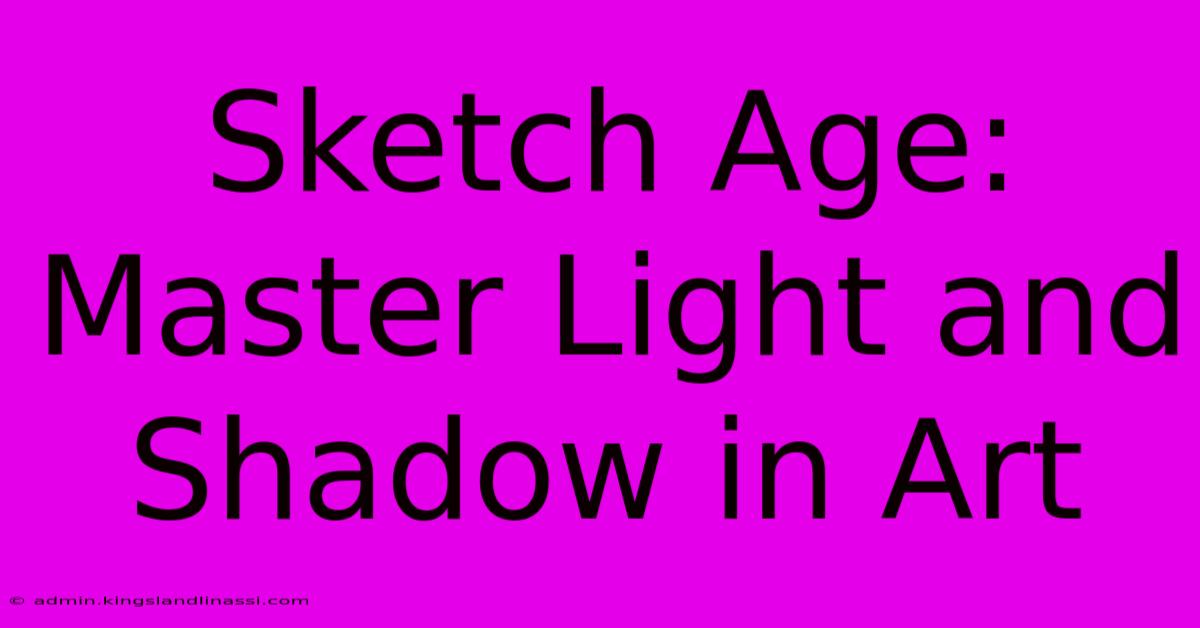Sketch Age: Master Light And Shadow In Art

Table of Contents
Sketch Age: Master Light and Shadow in Art
Want to elevate your sketching skills to the next level? Mastering light and shadow is the key to transforming your drawings from flat representations into dynamic, three-dimensional works of art. This comprehensive guide explores the essential techniques and concepts you need to understand to effectively utilize light and shadow in your sketches.
Understanding the Fundamentals of Light and Shadow
Before diving into techniques, it's crucial to grasp the fundamental principles governing light and shadow. Light sources, whether natural (sun, moon) or artificial (lamps, spotlights), dictate the interplay of light and shadow in your artwork. Understanding these basics is the bedrock of your sketching journey.
Key Terms to Know:
- Light Source: The origin of the light illuminating your subject. Identifying its position is the first step in understanding your scene's shadows.
- Highlight: The brightest area of your subject, where the light source directly hits.
- Mid-tones: Areas receiving indirect light; they bridge the gap between highlights and shadows.
- Core Shadow: The darkest area on your subject, directly opposite the light source.
- Cast Shadow: The shadow projected by the object onto a surface behind it.
- Reflected Light: Light bouncing off surrounding surfaces and illuminating shadowed areas. This subtly softens harsh shadows.
Practical Techniques for Rendering Light and Shadow
Now that we understand the fundamental concepts, let's explore practical techniques for effectively rendering light and shadow in your sketches:
1. Value Scales and Observation:
Creating a value scale (a grayscale ranging from pure white to pure black) is your first step. This helps you visually understand the range of tones in your subject. Careful observation is crucial; analyze how light falls on your subject, noting the variations in tone and the boundaries between light and shadow.
2. Hatching and Cross-Hatching:
These techniques involve using parallel lines (hatching) or intersecting lines (cross-hatching) to build up value and create the illusion of form. Closer lines create darker values, while more spaced-out lines create lighter values. Experiment with varying line weight and pressure to add depth and texture.
3. Blending and Smudging:
Techniques like blending stumps or tortillons can soften transitions between values, creating a smoother, more realistic effect. However, be mindful of over-blending, which can lead to muddy and indistinct forms.
4. Using Different Pencil Grades:
Utilizing a range of pencil grades (e.g., 2H, HB, 2B, 4B) allows you to create a wider range of values with precision. Harder pencils create lighter values, while softer pencils produce darker values.
Advanced Techniques: Taking it Further
As your skills develop, explore these advanced concepts to enhance your mastery of light and shadow:
1. Chiaroscuro:
This dramatic technique uses strong contrasts between light and dark to create a sense of depth and drama. It’s particularly effective for portraying strong emotions or intense moods.
2. Sfumato:
This subtle technique, famously used by Leonardo da Vinci, involves creating hazy, soft transitions between light and shadow, often used to render atmospheric perspective or soft skin textures.
Practice Makes Perfect: Tips for Improvement
Mastering light and shadow requires consistent practice. Here are some tips to accelerate your learning:
- Start with Simple Objects: Begin with simple shapes like spheres, cubes, and cylinders to understand how light interacts with basic forms.
- Use Reference Images: Observing real-life subjects and using reference photos is invaluable for improving your accuracy.
- Experiment with Different Light Sources: Try sketching the same object under various light sources to see how the shadows change.
- Seek Feedback: Share your work with fellow artists and seek constructive criticism.
By understanding the fundamentals, employing effective techniques, and dedicating yourself to consistent practice, you will soon master the art of light and shadow, transforming your sketches into captivating and expressive works of art. Remember, the journey of a thousand sketches begins with a single stroke!

Thank you for visiting our website wich cover about Sketch Age: Master Light And Shadow In Art. We hope the information provided has been useful to you. Feel free to contact us if you have any questions or need further assistance. See you next time and dont miss to bookmark.
Featured Posts
-
Shahid Kapoor Age And His Continuous Evolution As An Artist
Apr 28, 2025
-
Anushka Sharmas Wealth A Tale Of Success
Apr 28, 2025
-
Vivek Oberois Net Worth The Numbers Dont Lie
Apr 28, 2025
-
Your Age Your Pulse Understanding Pulse Rate Normal Range By Age
Apr 28, 2025
-
Unveiling Lele Ponss Real Age You Wont Believe It
Apr 28, 2025
